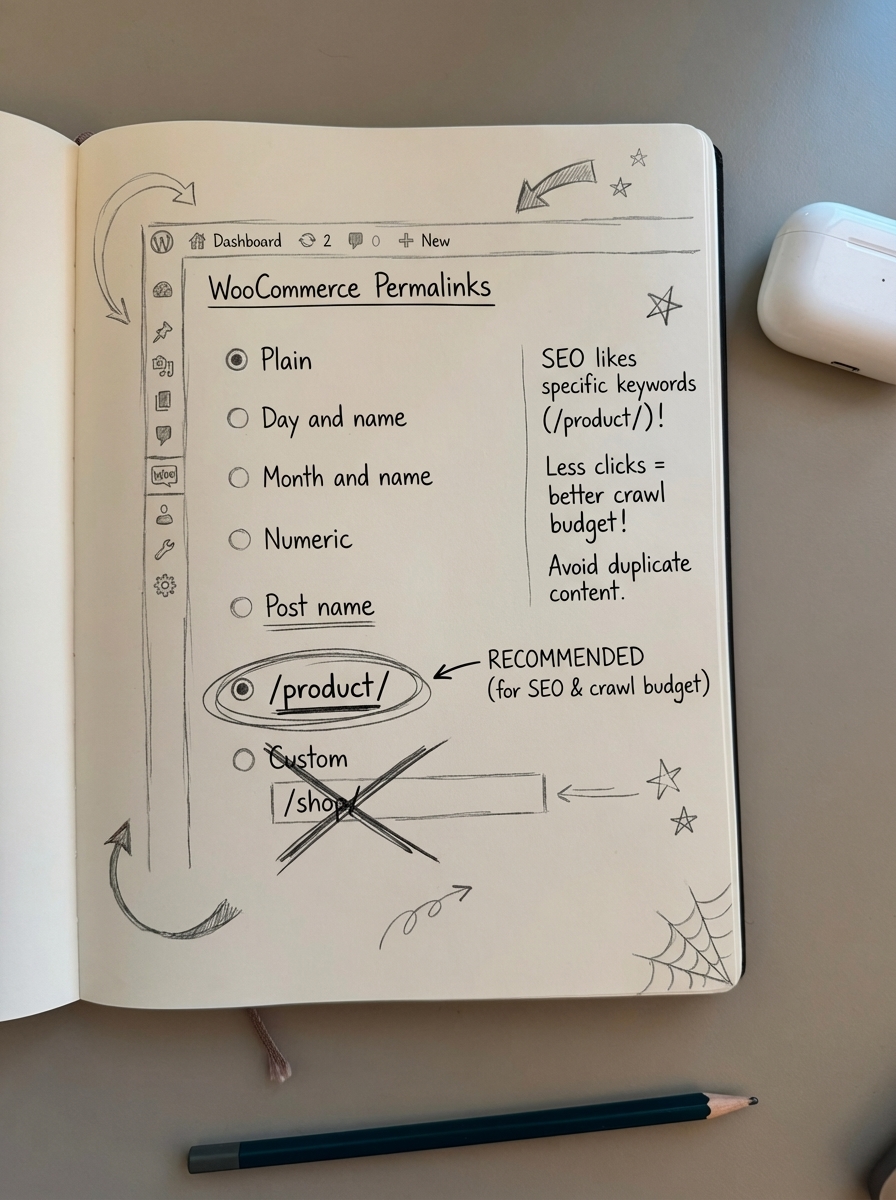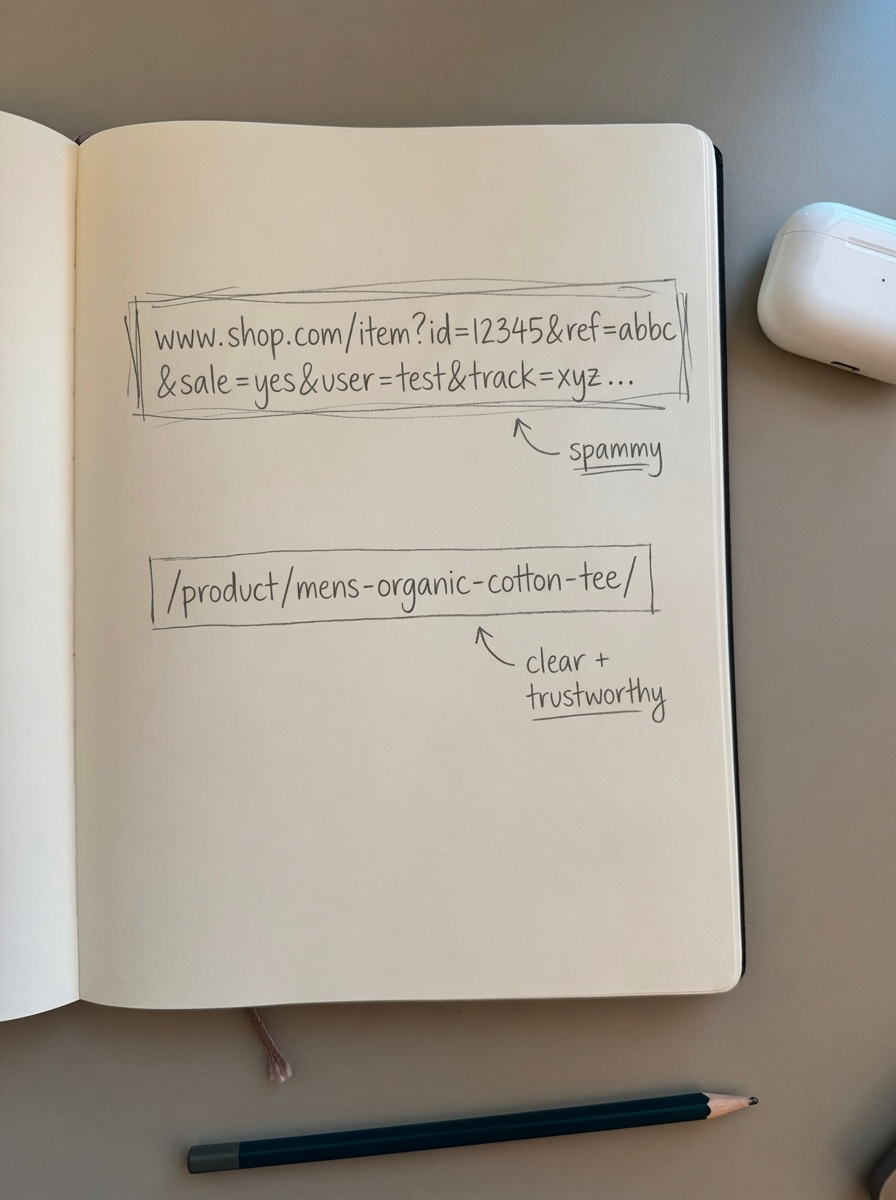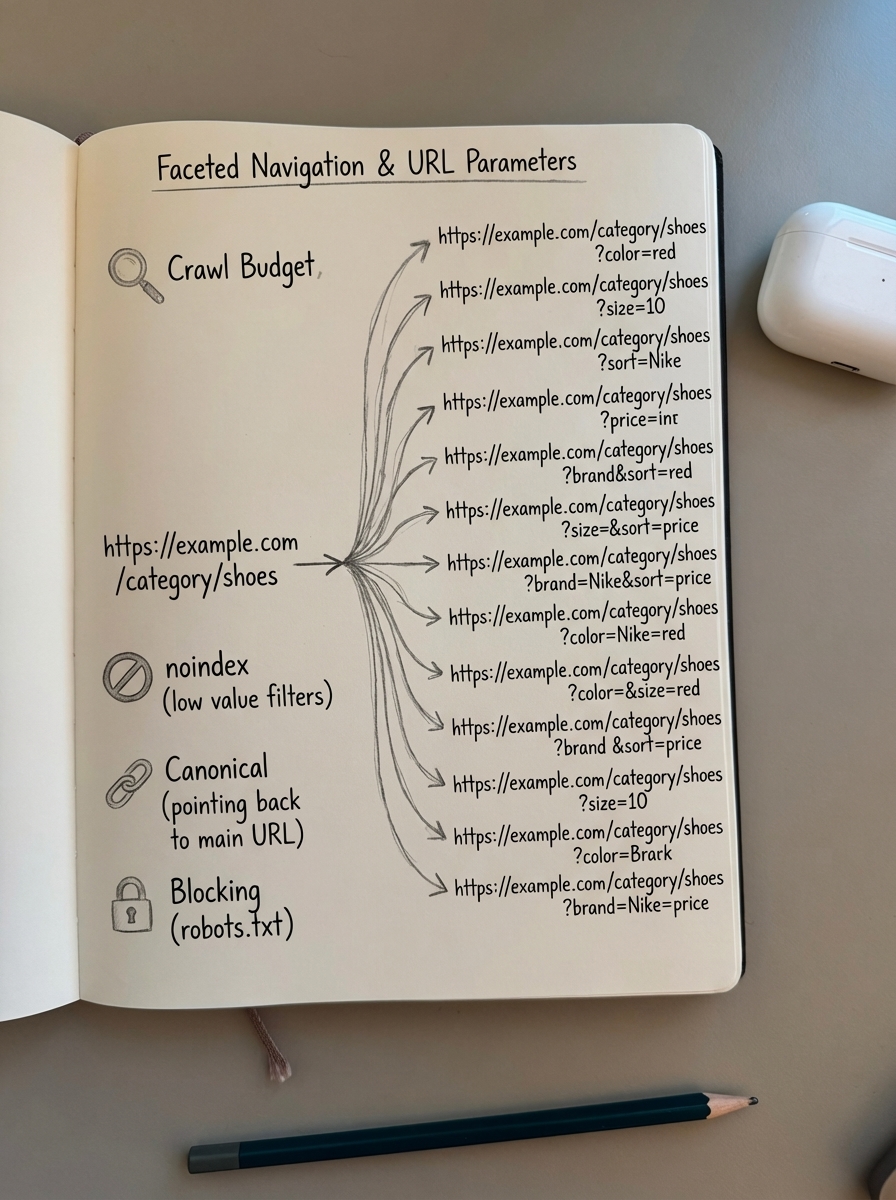WooCommerce URL structure: Configure permalinks for SEO and conversion
Your WooCommerce permalink structure determines whether Google crawls your best pages or wastes time on duplicate junk. I’ve watched stores tank 40% of their traffic by changing /product/ to /shop/ without redirects – recovery took months and cost six figures.
URLs are a minor ranking factor, but descriptive slugs containing target keywords help search engines and users identify content before clicking. More critically, your structure dictates crawl budget allocation across thousands of SKUs. Poor structure forces Google to index duplicate URLs from filters, variations, and parameters instead of your money pages.
Why WooCommerce URL structure matters for SEO
Google uses URL patterns to understand site hierarchy. A clean structure preserves crawl budget – essential when managing large catalogs. SEMrush’s 2023 audit found 72% of e-commerce sites have robots.txt configurations that block indexable content, with 38% blocking critical product pages. The inverse problem – under-blocking – wastes crawl budget on checkout flows and faceted navigation.
WooCommerce defaults create predictable patterns: products at /product/product-name/, categories at /product-category/category-name/, tags at /product-tag/tag-name/. These work but aren’t optimized for SEO or large catalogs.
Your URL structure also impacts duplicate content issues. Product variations, category assignments, and filter parameters all generate new URLs pointing to identical or near-identical content. Without proper canonicalization, you dilute ranking signals across dozens of URLs.
Configuring WooCommerce permalink settings
Navigate to Settings → Permalinks in WordPress. Scroll to “Product permalinks.”

Product base options:
- Default (
/product/): Signals page type to search engines, helps with indexation prioritization and structured data validation - Shop base (
/shop/): Shorter but requires redirect management - Custom base: Full control, higher maintenance
- No base (
/product-name/): Cleanest URLs, highest collision risk
I keep /product/ for most stores. It’s longer, but clarity beats brevity when you’re managing crawl budget. Category pages with the category base help establish site hierarchy and should be preserved for optimal site architecture.
Category base options:
The default /product-category/ wastes characters. Change it to /category/ or a niche-specific base (/gear/ for outdoor stores). For high-value categories, remove the base entirely: /running-shoes/ beats /category/running-shoes/ for keyword prominence and user trust.
Warning: Removing category bases creates slug collisions. If you have a page and a category called “About,” they’ll fight for /about/. Audit existing slugs first.
To change settings, update the fields, click “Save Changes,” then immediately set up 301 redirects for every old URL. Test in staging. Monitor Search Console daily for 30 days.
Optimizing product URLs for SEO
Keep permalinks concise and keyword-focused. A URL like /product/mens-organic-cotton-t-shirt-blue-medium-summer-2024/ looks spammy and converts worse than /product/mens-organic-cotton-tee/.

Best practices:
- Include primary keyword (“running-shoes” not “product-12345”)
- Use hyphens to separate words (never underscores)
- Remove stop words (“the,” “and,” “of”)
- Keep under 60 characters
- Use lowercase exclusively
Avoid special characters and parameters in base product URLs. Parameters work for filters, but your canonical URL must be clean. Product variations (color, size) should use parameters like ?attribute_color=blue and canonicalize to the parent product to prevent duplicate content.
Edit slugs when creating products. WordPress auto-generates slugs from titles, but “Men’s Organic Cotton T-Shirt – Blue – Limited Edition Summer 2024” becomes a disaster. Manually override to “mens-organic-cotton-tee” before publishing.
Category and archive URL optimization
Categories target higher-volume keywords than individual products and serve as internal linking hubs. Structure them semantically to mirror navigation:
/running-shoes//running-shoes/trail//running-shoes/trail/waterproof/This hierarchy communicates topical relationships to Google and creates natural breadcrumb paths. Avoid nesting beyond three levels – deeper structures dilute topical authority and bury products from the homepage.
Pagination: WooCommerce handles paginated URLs automatically (/category-name/page/2/). Don’t block these in robots.txt. Each paginated page needs a self-referencing canonical tag, not a canonical to page one. Google deprecated rel=“next”/rel=“prev” in 2019, so proper self-canonicalization matters.
Most stores use generic category names (“Shoes”) when specific alternatives (“Women’s Trail Running Shoes”) capture more search volume. ContentGecko’s free category optimizer analyzes your store and suggests optimized titles that match buyer search patterns. The tool typically takes a few minutes and requires only your domain.
Handling URL parameters and filtering
Faceted navigation explodes URL combinations. Five attributes with ten values each creates 100,000 potential URLs. Most are worthless for SEO and waste crawl budget.

Tiered parameter strategy:
- High-value combinations: Use path-based URLs for proven search demand (
/mens-running-shoes-size-10/) - Medium-value: Allow parameters but canonicalize to base category
- Low-value: Block from crawling or add noindex meta tags
Configure URL parameter handling in Google Search Console under Settings → Crawling → URL Parameters. Specify whether parameters change content (filter by color) or just reorder (sort by price). This prevents crawl waste on duplicates.
Common parameters:
?orderby=(sorting): Canonical to base category, or noindex?filter_color=(filtering): Selective indexation for high-demand combos?add-to-cart=(cart actions): Block in robots.txt?s=(search): Allow crawling, noindex results
For detailed implementation including JavaScript-based faceting and crawl budget optimization, see our faceted navigation SEO guide. That guide covers the five-tier indexing policy for managing filter combinations at scale.
Changing URL structure without killing your rankings
Every URL change carries risk. I’ve executed dozens of migrations – comprehensive redirects succeed, partial coverage fails catastrophically. Companies lose up to 80% of organic traffic during poorly executed migrations.
Pre-migration checklist:
- Crawl current site with Screaming Frog, export all URLs
- Document traffic and rankings for top 100 pages
- Build 1:1 URL mapping spreadsheet (old URL → new URL → redirect type)
- Set up 301 redirects for every changed URL
- Test all redirects in staging (check for chains, loops, 404s)
- Update internal links sitewide before launch
- Monitor Google Search Console and traffic daily for 30 days
Plugins like Redirection or Yoast Premium manage redirects, but for catalogs over 1,000 products, implement server-level redirects in .htaccess or Nginx config for better performance. Each redirect adds 200–300ms of load time, so server-level implementation reduces overhead.
Fatal mistakes:
- Redirecting everything to the homepage (preserves zero SEO equity)
- Forgetting product variation URLs
- Creating redirect chains (A→B→C instead of A→C directly)
- Not updating internal links in content
- Migrating during peak sales periods
When you change permalink structures, ContentGecko’s WordPress connector plugin automatically updates internal links in all generated content. If /product/blue-widget/ becomes /blue-widget/, we rewrite every reference in blog posts, buyer guides, and category descriptions. This maintains link equity and prevents 404s without manual find-and-replace across hundreds of posts.
Technical considerations for large catalogs
Crawl budget matters above 10,000 products. Google allocates finite crawl resources based on site authority and technical health. Poorly structured URLs waste up to 70% of crawl budget on duplicates or low-value pages.
Monitor crawl efficiency in Google Search Console: Settings → Crawl Stats. Look for total requests, average response time, crawl errors, and robots.txt fetch failures. If Google crawls hundreds of filtered pages with minimal indexation, your URL structure bleeds crawl budget.
URL cleanup strategies:
- Block filter parameters in robots.txt (
Disallow: /*?filter_) - Add
noindex, followmeta tags to filtered pages via conditional logic - Implement canonical tags to consolidate duplicates
- Use
rel="nofollow"on low-value filter links to conserve crawl budget
Sitemap optimization: Your XML sitemap should include only canonical URLs. Exclude filtered pages, temporary URLs, out-of-stock products, and redirected pages. For stores above 50,000 URLs, split into separate product, category, and blog sitemaps to stay under the 50MB / 50,000 URL limits.
Always include your XML sitemap location in robots.txt to ensure proper discovery of product and category pages. Most SEO plugins handle this automatically, but verify by checking yourdomain.com/robots.txt in a browser.
Measuring URL structure impact
Track these metrics before and after changes:
- Indexation rate: Pages indexed ÷ pages submitted in sitemap
- Organic landing pages: Unique URLs receiving search traffic (Search Console → Performance → Pages)
- Crawl efficiency: Pages crawled ÷ pages indexed (under 2:1 is healthy)
- Average position: Monitor category and product rankings by segment
Use ContentGecko’s e-commerce SEO dashboard to segment performance by page type. We break down impressions, clicks, CTR, and position separately for products, categories, and blog posts. Configure page type filters by entering URL patterns (products usually include /product/, categories /category/ or /product-category/, blog posts /blog/). This reveals which URL structures drive performance and which need optimization.
Well-optimized URL structures typically lift organic CTR by 5–15% because users trust clear, descriptive URLs over cryptic parameter strings. Track CTR in Search Console by filtering for specific URL patterns, then compare before/after periods.
URL structure and content automation
Your URL structure determines how effectively automated content drives SEO. ContentGecko consumes your WooCommerce category hierarchy and product slugs to build semantically relevant internal links in all generated content.
When we create a buyer guide for “trail running shoes,” we automatically link to your category hub (/running-shoes/trail/), featured products (/product/salomon-speedcross-5/), and related blog posts. This only works if your URL structure is logical and consistent.
Inconsistent slugs, missing categories, or frequent URL changes break the automated linking engine. If /mens-tshirts/ becomes /mens-apparel/shirts/ without redirects, every link in previously published content breaks. Our plugin updates links when URLs change, but prevention beats remediation – design your URL structure for stability.
Intent-based keyword clustering improves content relevance by up to 40% when URL structures align with semantic topics. If your categories are poorly named or overly broad (“Products”), automated content can’t target specific buyer intent. Rename categories to match search behavior before deploying catalog-synced content.
TL;DR
Configure permalinks in Settings → Permalinks. Keep /product/ for products and simplify category bases to /category/ or remove them entirely for high-value categories. Use descriptive, keyword-rich slugs under 60 characters with hyphens between words. Handle filter parameters with a tiered strategy: index high-value combinations, canonicalize medium-value, block or noindex low-value. Always implement 301 redirects when changing URLs – one-to-one mapping, not mass redirects to homepage. Block low-value parameters in robots.txt, include only canonical URLs in XML sitemaps, and monitor crawl efficiency in Search Console. Track impact with segmented analytics using ContentGecko’s dashboard to measure which URL patterns drive organic performance.
